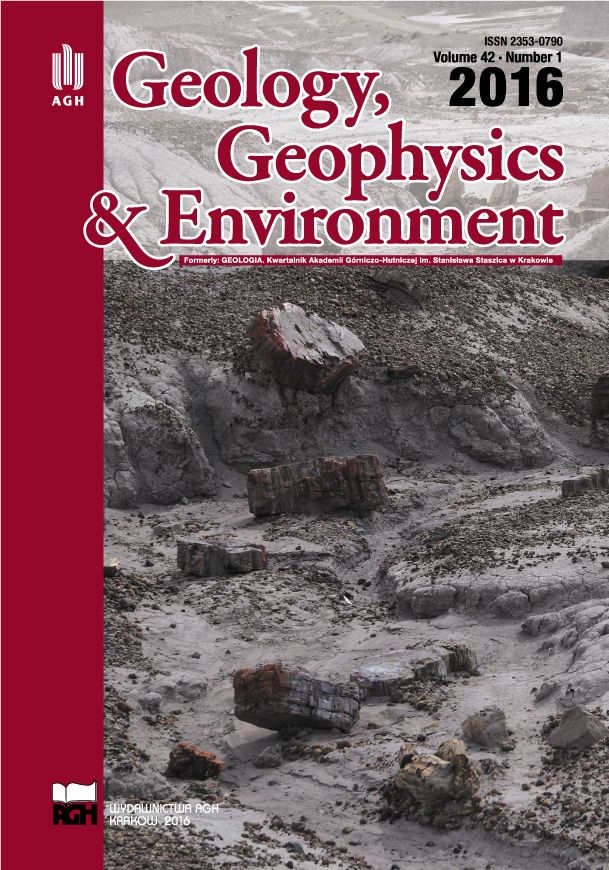Ludwigite-group minerals and szaibélyite: rare borate minerals from Vysoká – Zlatno skarn, Štiavnica stratovolcano, Slovakia
DOI:
https://doi.org/10.7494/geol.2016.42.1.59Abstract
Beside of sedimentary evaporitic rocks, borate minerals occur also in some high temperature contact-metamorphic rocks, especially in skarns, locally in association with Fe and Sn ore minerals (e.g., Anovitz and Grew, 1996). The borate minerals are generally associated to the post-magmatic processes which occur in the contact aureolas of intrusive, acid to intermediary, calc-alkaline rocks (Pertsev, 1991). Borate minerals of the ludwigite group and szaibélyite were identificated from the Mg-skarn in the R-20 drilling core during geological exploration for Cu-Au porphyry-skarn ores in the Vysoká – Zlatno area near Banská Štiavnica, in the Štiavnica Neogene stratovolcano, centralSlovakia(Koděra et al., 2010).
Ludwigite-group minerals (LGM) form massive black aggregates (>5 cmlarge) of numerous acicular, euhedral to subhedral prismatic crystals (usually 0.2 to 3 mmlong). Ludwigite associates with clinohumite, szaibelyite, clinochlore, serpentine-group mineral, magnesite, dolomite, hematite, rarely valeriite, chalcopyrite, and sphalerite. Under transmitted light, LGM crystals are mostly opaque; locally they are translucent with strong pleochroism in sections parallel to z-axis (deep green - dark reddish brown). In BSE, LGM crystals show regular concentric, rarely oscillatory or irregular zoning caused by distinct element variations during their growth or partial alteration: the dark zones show enrichment in Mg, Al and Ti, in contrast to the pale zones which reveal larger amounts of Fe. The electron-microprobe analyses reveal growth evolution of LGM crystals from Al-rich azoproite [with £79 mol.% of Mg2(Mg0.5Ti0.5)(BO3)O2 end-member] to Al±Ti-rich ludwigite and Al-dominant LGM phase [“aluminoludwigite” with £53 mol.% of Mg2Al(BO3)O2 end-member] in central zones, whereas rim zones of the crystals and secondary veinlets attain nearly pure ludwigite composition [87–99 mol.% of Mg2Fe3+(BO3)O2 end-member]. Consequently, LGM from the Vysoká – Zlatno skarn show the largest compositional variations ever known from one occurrence and they reach the highest contents of Ti (£17.4 wt.% TiO2, 0.39 apfu) and Al (£14.4 wt.% Al2O3,0.53 apfu) ever reported in LGM (Schaller and Vlisidis, 1961; Marincea, 2000; Pertsev et al., 2004; Aleksandrov and Troneva, 2008, 2011).
The compositional variations indicate the following substitution mechanisms in the studied LGM: Mg2+ = Fe2+ for the all compositions, Fe3+ = Al3+ for samples without higher amount of Ti, and 2Al = Mg2++Ti4+ or 2Fe3+ = Mg2++Ti4+ for analyses including high Ti content.
Szaibélyite MgBO2(OH) occurs as aggregates of fibrous crystals, up to 0.5 mm in size, replacing LGM. Zoning in szaibélyite was not observed. The amounts of Mg are uniform (0.98 to 0.99 apfu), content of Fe2+ oscillates from 0.2 to 1.2 wt.% FeO (0.002–0.014 apfu) and indicates the Mg2+ = Fe2+ substitution. Szaibélyite also contains small admixtures of Mn (0.1–0.4 wt.% MnO), Al and Cr (£0.3 wt.% Al2O3 or Cr2O3).
The skarn mineralization originated as a result of contact thermal metamorphism of Miocene calc-alkaline granodiorite intrusion on host Middle to Upper Triassic limestones, dolomites, shales and evaporitic anhydrite beds (the Veľký Bok Group). The evaporites were most likely the primary source of boron, whereas Ti was probably derived from the granodiorite. Clinohumite and LGM (azoproite to Al±Ti-rich ludwigite and “aluminoludwigite”) precipitated during the high-temperature contact metamorphic event at ~700 °C and £100 MPa, whereas the youngest Al,Ti-poor ludwigite veinlets, szaibéllyite, serpentine-group mineral, clinochlore, magnesite, dolomite, hematite and probably also sulfide minerals were formed during younger, lower-temperature hydrothermal-metasomatic event.
Downloads
References
Aleksandrov, S.M., & Troneva, M.A., 2008. Heterovalent isomorphism in the Magnesium–Iron Borates. Geochemistry International, 46, 800–813.
Aleksandrov, S.M., & Troneva, M.A., 2011. Genesis and Composition of Endogenous Borates in the Skarns of the Eastern and Central Pyrenees. Geochemistry International, 49, 802–814.
Anovitz, LM., & Grew, E.S., 1996. Mineralogy, petrology and geochernistry of boron: an introduction. Min. Soc. America, 33, 1-40.
Koděra P., Lexa J., Fallick A. E., 2010. Formation of the Vysoká-Zlatno Cu-Au skarn-porphyry deposit, Slovakia. Miner. Depos., 45, 817-843.
Marincea, S., 2000. The influence of Al on the physical and crystallographic properties of ludwigite in three Romanian occurrences. Eur. J. Mineral., 12, 809-823.
Persev, N.N. 1991. Magnesian skarns. In: Skarns: their genesis and metallogeny. Theophrastus Publications, 299-324.
Pertsev, N. N., Schreyer, W., Armbruster T., Bernhard, H.J., Medenbach, O., 2004. Alumino-magnesiohulsite, a new member of the hulsite group, in kotoite marble from east of Verkhoyansk, Sakha-Yakutia, Russia. Eur. J. Mineral., 16, 151–161.
Schaller, W.T., & Vlisidis, A.C., 1961. Composition of aluminian ludwigite from Crestmore, California. Am. Mineral., 46, 335-339.
Downloads
Published
Issue
Section
License
Authors have full copyright and property rights to their work. Their copyrights to store the work, duplicate it in printing (as well as in the form of a digital CD recording), to make it available in the digital form, on the Internet and putting into circulation multiplied copies of the work worldwide are unlimited.
The content of the journal is freely available according to the Creative Commons License Attribution 4.0 International (CC BY 4.0)










